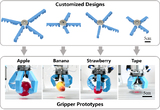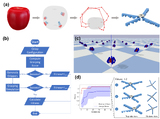Jiayi Jin
Hi, I'm Jiayi Jin. I am a Mechanical Engineering Ph.D. student at UW-Madison. I received my bachelor's degree in Mechanical Engineering from Tsinghua University in 2024. My research interests include soft robotics, robot design, simulation, and control. Besides, I am also a lover of photographing and hiking.

Publications

Computational Design of Customized Vacuum-Driven Soft Grippers
IEEE Robotics and Automation Letters, 2024
bib
Soft grippers are increasingly favored due to their passive compliance, lack of need for precise force control, and high adaptability to various object shapes. Unlike previous soft grippers that are mostly universal, we propose a framework for the computational design and rapid fabrication of customized soft grippers using a specific class of vacuum-driven pneumatic actuators. The algorithm can automatically generate a 3D-printable model of the optimized gripper design, and then the gripper can be rapidly fabricated at a low cost. Grasping experiments demonstrate that this framework can customize grippers for various daily objects with different geometries. The results also show the extensional abilities of customizing a gripper for multiple or heavy objects. This framework enables the rapid design and fabrication of grippers optimized for specific tasks while maintaining versatility for handling various objects.

Data-driven inpainting for full-part temperature monitoring in additive manufacturing
Journal of Manufacturing Systems, 2024
bib
Understanding the temperature history over a part during additive manufacturing (AM) is important for optimizing the process and ensuring product quality, as temperature impacts melt pool geometry, defect formation, and microstructure evolution. While in-process temperature monitoring holds promise for evaluating the part quality, existing thermal sensors used in AM provide only partial measurements of the temperature distribution over the part. In this work, we introduce an innovative approach for reconstructing the complete temperature profile using partial data. We formulate this challenge as an inpainting problem, a canonical task in machine learning which entails recovering missing information across a spatial domain. We present a data-driven model based on graph convolutional neural networks. To train the inpainting model, we employ a finite element simulation to generate a diverse dataset of temperature histories for various part geometries. Cross-validation indicates that the inpainting model accurately reconstructs the spatial distribution of part temperature with strong generalizability across various geometries. Further application to experimental data using infrared camera measurements shows that the model accuracy could be improved by augmenting the training data with simulation data that shares process parameters and geometry with the experimental part. By presenting a solution to the temperature inpainting problem, our approach not only improves the assessment of part quality using partial measurements but also paves the way for the creation of a temperature digital twin of the part using thermal sensors.
